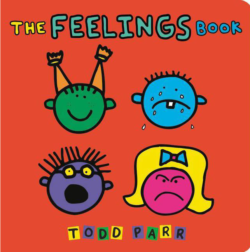FAVORITE BOOK BLOG (WITH ACTIVITIES)
by Heidi Altescu, PhD
G&R Inclusive Group
Director of Inclusive Coaching and Research
Read all of your books, now what?
I am not sure about you, but through all of this virtual home
schooling – all of our books have been read. Kids just outgrow them right before your eyes! Many parents in our local blogs have been left wondering, what books are next? What would they be reading in school right now? What will push their thinking? Creativity? Empathy? Resilience?
So… we thought we would start a list of staff books that we love (and hopefully your little one will as well!):
Our first favorite book is Todd Parrs’- The Feelings Book (2000).

We have gotten tons of mileage from this book and reference it over and over through some big toddler emotions (and grown up emotions!). The drawn pictures are over exaggerated to show emotions with tons of silly-toddler-fun mixed in as well. We usually read it at bedtime as a family and each one of us act out the emotion that we are reading. Below is an example of our family conversation:
“Sometimes I feel Angry..” (by Todd Parr, 2000)
What does it look like when you feel angry? We over exaggerate making a (usually silly) face, clench our hands, cross our arms, etc.
What does it sound like when you feel angry? We over exaggerate stomping our feet, talk about using outside voice inside the apartment.
What can we do when you feel angry? Tell an adult how you feel and a solution to the problem- “I am angry because, you did not listen to me and I want you to listen to me”. I am angry because my (block) building fell down, I will try it again”
It gets really silly pretty fast but it has been a fun way to talk about, label and even act out big emotions- all practice! We are all usually laughing by the end of the book.
Then when WE have these emotions during the day, we can name them together as a family.
How do we connect IEP goals?:
*Receptive language– listening to speaker for understanding (what do you look like when you are angry?) Child starts organizing their answer back to you.
*Expressive Language– Answering the question that was asked ( I look like… I sound like… or I can do..) Or asking the question to the parent (What does it sound like when you are angry?)
*Executive Function– Waiting their turn
*Social Emotional– Connecting language to feelings in the body. Creating and finding ways to help them problem solve and release emotions.
*Pre-Reading skills: Using the book together, turning pictures from front-back and reading and finding meaning to the pictures. Pointing to the words as you read them helps kids connect meaning to groups of letters. Also, reading with intonation and inflection support understanding and reading fluency.
Other fun activities!
*Use a mirror and play out different emotions so child can see their own face
*Use the language in pretend play with their stuffed animals or dolls, etc.
*Ask high-level question during the activity- usually asking How and Why questions instead of What
*Draw pictures of different emotions- connect colors, shapes and sizes to variety of emotions
*Use expanded language from the basic words (for example add onto angry- mad, furious, even frustrated)
Another great book we would recommend is Todd Parrs- It’s OKAY to be Different (2001).
1- A couple of quick resources on why we read with children
2- **NYC-Childrens Reading Theatre- support another local company? https://nycchildrenstheater.org/the-importance-of-reading-together/
3- **Teaching Tolerance-Reading Together: https://nycchildrenstheater.org/the-importance-of-reading-together/
4- **Scholastic Report- https://www.scholastic.com/content/dam/KFRR/Downloads/KFRReport_Finding%20Their%20Story.pdf